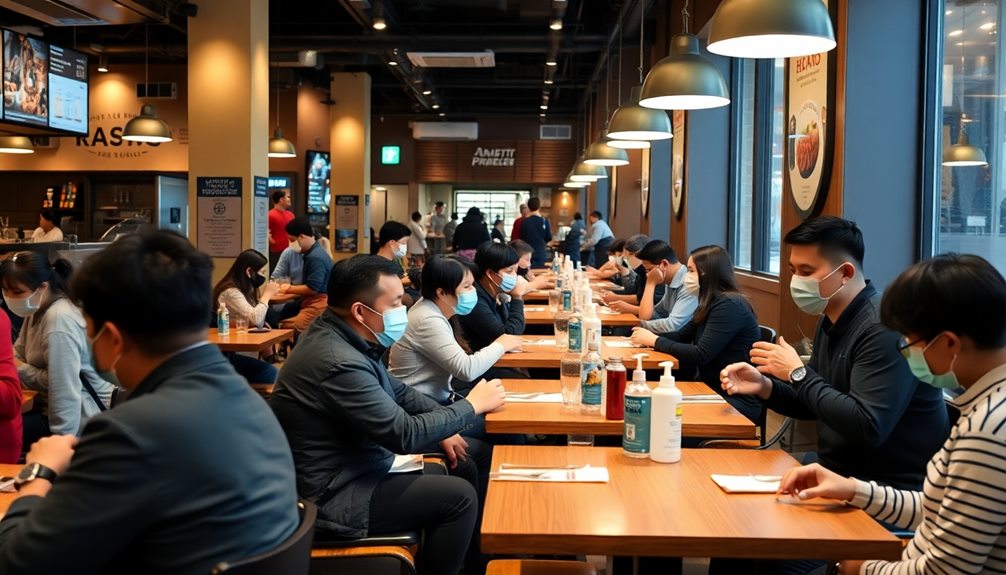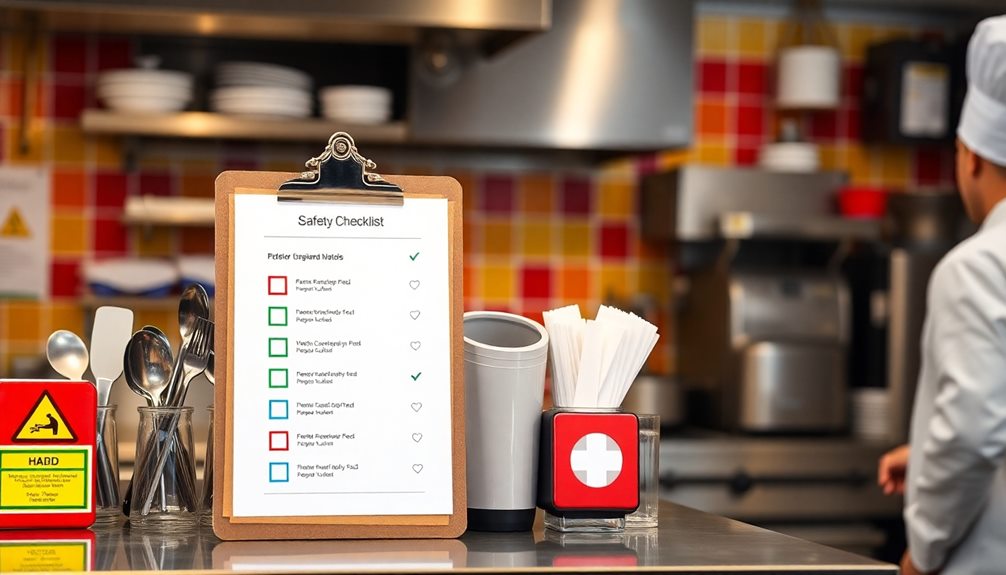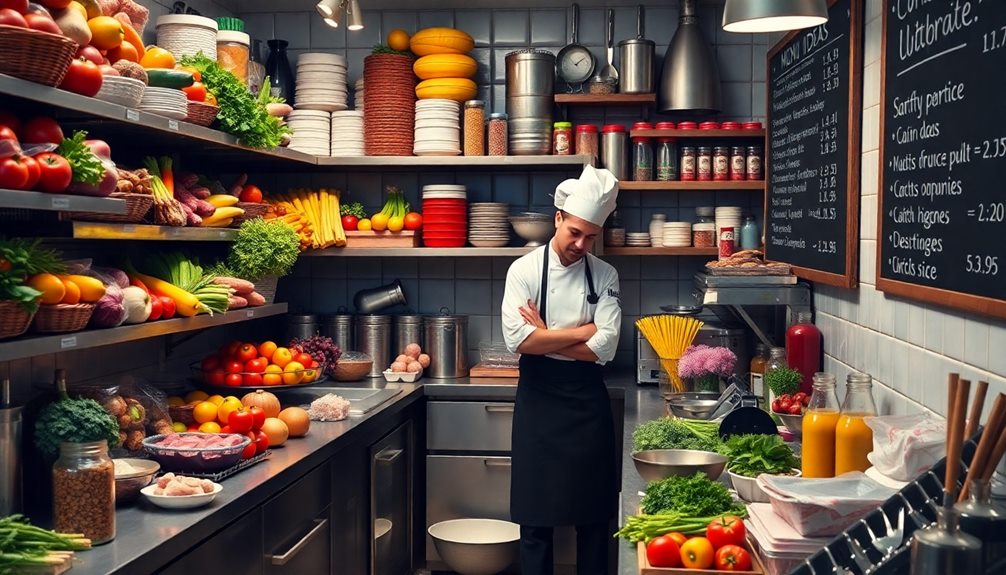Restaurants are prioritizing your safety by implementing various COVID-19 measures. They follow health guidelines for sanitization, ensuring high-touch surfaces are cleaned frequently. You'll find social distancing protocols in place, with tables spaced apart to reduce transmission risks. Staff are required to wear masks and undergo health screenings to protect everyone. Many places now offer digital menus and contactless payment options for added safety. Transparency is key; you're likely to see clear signs detailing their safety practices. If you want to discover even more about these initiatives and how they enhance your dining experience, there's still more to explore.
Key Takeaways
- Restaurants must implement health screening protocols and encourage employees to stay home if symptomatic to ensure overall safety.
- Enhanced cleaning practices, including frequent sanitization of high-touch surfaces, are essential to mitigate COVID-19 transmission risks.
- Social distancing measures, such as table spacing and capacity limits, significantly reduce the risk of virus spread within dining areas.
- Clear customer communication about safety measures and operational changes builds trust and keeps patrons informed during the pandemic.
- Adoption of digital menus and contactless payment options improves customer safety and enhances the dining experience.
Safe Operations and Guidelines

To guarantee safe operations during the COVID-19 pandemic, restaurants must adopt guidelines that prioritize health and safety. Implementing food safety guidelines is vital, especially as the Texas Restaurant Promise encourages adherence to CDC recommendations.
Since current executive orders in Texas don't enforce government mask mandates, it's up to you as a restaurant owner to establish your own policies. Enforcing social distancing measures, such as spacing tables and limiting capacity, can considerably reduce the risk of virus transmission.
You should also prioritize the well-being of your restaurant employees by providing clear instructions on safety protocols. Enhanced cleaning and sanitation protocols are essential; make sure to frequently disinfect high-touch surfaces like menus, door handles, and restrooms.
This won't only help you comply with health recommendations but also reassure your customers about their safety.
Additionally, the Texas Restaurant Association offers resources for legal support and best practices to navigate these challenging times. By adopting these measures, you'll create a safer dining environment that protects both your employees and customers, ensuring your restaurant can thrive amidst the pandemic's challenges.
Vaccine Access and Information
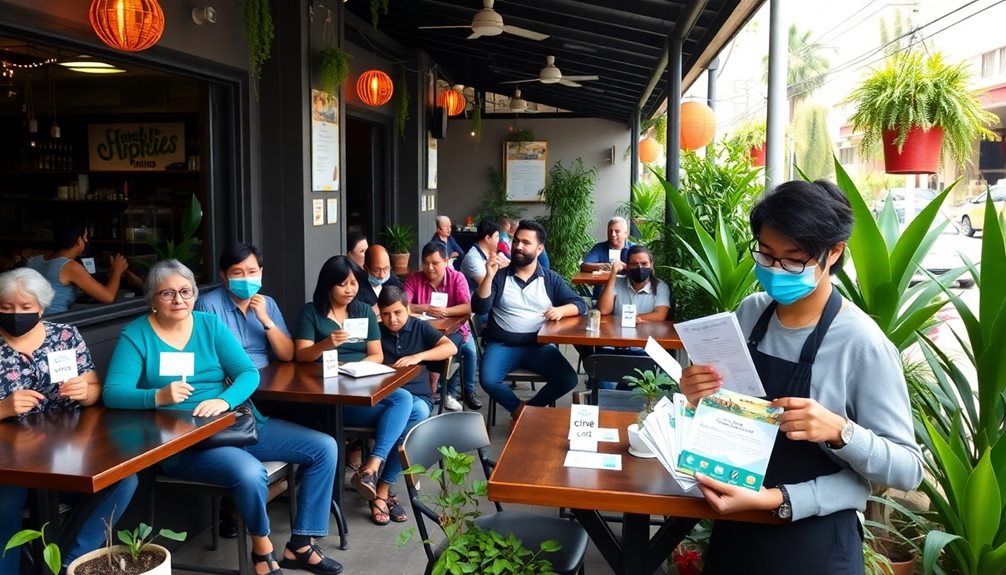
When it comes to getting vaccinated, you'll find that COVID-19 vaccines are available at no cost, making it easy for everyone to access them.
Many employers even offer paid time off for vaccinations, which can help you prioritize your health.
For accurate information on where to get vaccinated and the safety measures in place, check out resources from the CDC and Texas DSHS.
Vaccine Accessibility for All
Vaccines against COVID-19 are available to everyone at no cost, making it easier for you to protect yourself and your community. Ensuring vaccine accessibility is essential for public health, especially for vulnerable populations who may face greater risks from the virus.
The Biden administration has emphasized equitable access, making sure that no one faces discrimination based on immigration status when seeking vaccination. This commitment helps create an inclusive environment where everyone can participate in safeguarding their health.
Additionally, employers play an important role in facilitating vaccine access. They can choose to compensate employees for the time taken to receive vaccinations, which encourages more individuals to get vaccinated without financial concerns.
This approach not only supports public health but also shows a commitment to the well-being of all employees.
Employer Vaccination Policies
Employers have a significant role in shaping their workplace vaccination policies, ensuring that employees have access to COVID-19 vaccines. Many employers may choose to require vaccinations, but they must also provide reasonable accommodations for employees with valid medical or religious exemptions. This balance is essential for maintaining a safe work environment while respecting individual rights.
It's important to note that COVID-19 vaccinations are free for everyone, and while insurance may be requested, it's not a requirement for access. To support employees, the Families First Coronavirus Response Act (FFCRA) allows employers to compensate workers for the time spent getting vaccinated, which helps reduce barriers to participation.
The Biden administration emphasizes equitable access to vaccines, ensuring that no one faces discrimination based on their immigration status. Employers can play a significant role in this effort by staying informed and providing thorough vaccination information.
Resources from the CDC and Texas DSHS can help educate your workforce, making it easier for everyone to understand the importance of vaccinations for their safety and the safety of others in the restaurant environment. By prioritizing vaccination, you contribute to a safer workplace for all.
Relief and Support Initiatives
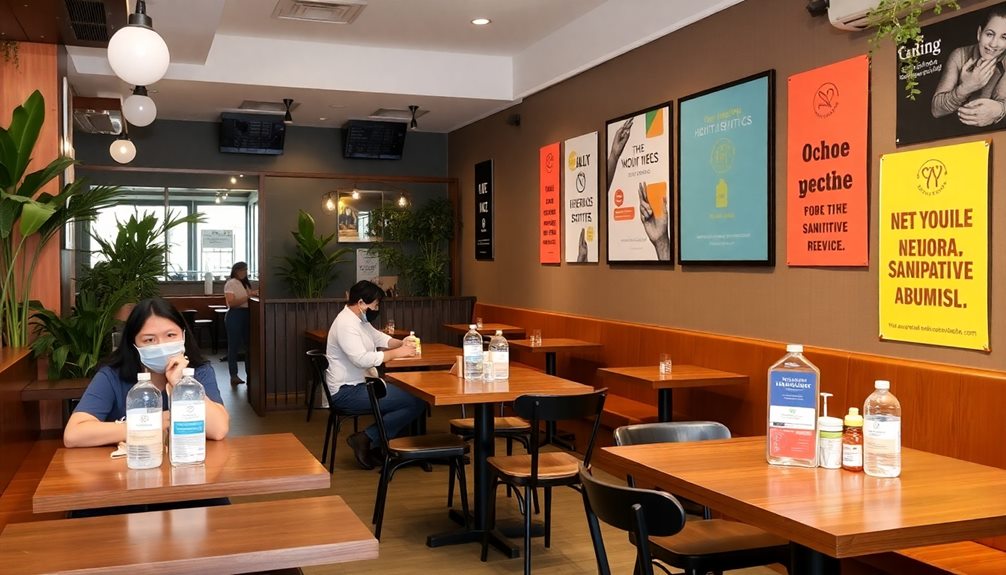
As you navigate the challenges posed by the pandemic, various relief and support initiatives can help your restaurant stay afloat.
Programs like the Restaurant Revitalization Fund and Employee Retention Tax Credit offer essential financial assistance, while community efforts, such as meal donation programs, strengthen local ties.
Exploring these resources can make a significant difference in your recovery journey.
Financial Assistance Programs
Many restaurants have faced unprecedented challenges due to the COVID-19 pandemic, but several financial assistance programs have emerged to help them navigate these tough times. Significantly, the Restaurant Revitalization Fund (RRF) provides essential support to cover operational costs and facilitate recovery. The Employee Retention Tax Credit (ERTC) offers considerable incentives for businesses that retain employees during revenue dips, further aiding financial stability. Another important initiative is the Paycheck Protection Program (PPP), which supplied forgivable loans to help maintain payroll and other essential expenses.
Here's a quick overview of some programs available:
| Program Name | Description | Eligibility Criteria |
|---|---|---|
| Restaurant Revitalization Fund | Direct financial support for restaurants | Must be independently owned |
| Employee Retention Tax Credit | Incentives to retain employees | Must meet revenue decline criteria |
| Paycheck Protection Program | Forgivable loans for payroll | Must maintain employee count |
| Texas Restaurant Association Fund | Relief for independently-owned restaurants | Economic hardship due to COVID-19 |
| CORE Support & James Beard Fund | Assistance for food service employees | Affected by pandemic |
These programs are essential in helping restaurants survive and thrive during these challenging times.
Community Support Initiatives
Community support initiatives have become a lifeline for restaurants during the pandemic, fostering resilience and solidarity within the industry. Programs like the Restaurant Revitalization Fund (RRF) and the Texas Restaurant Association's Relief Fund are critical resources, offering financial support to independently-owned restaurants struggling to recover. These initiatives provide much-needed assistance to help you navigate economic challenges.
The Employee Retention Tax Credit (ERTC) also plays an essential role by incentivizing businesses to keep their employees on payroll, ensuring your workforce remains intact during these tough times.
Additionally, the Comfort Food Care Package Program (CFCP) addresses food insecurity by donating meals to at-risk youth and families in Texas, allowing you to give back to the community while supporting your restaurant.
Organizations like the James Beard Relief Fund and CORE Support take it a step further, providing crucial assistance to food service employees facing crises.
These community support initiatives not only highlight the industry's commitment to its workforce but also enhance community bonds. By participating in these programs, you contribute to a collective effort to sustain your restaurant and uplift those around you during this unprecedented time.
Employee Health and Resources
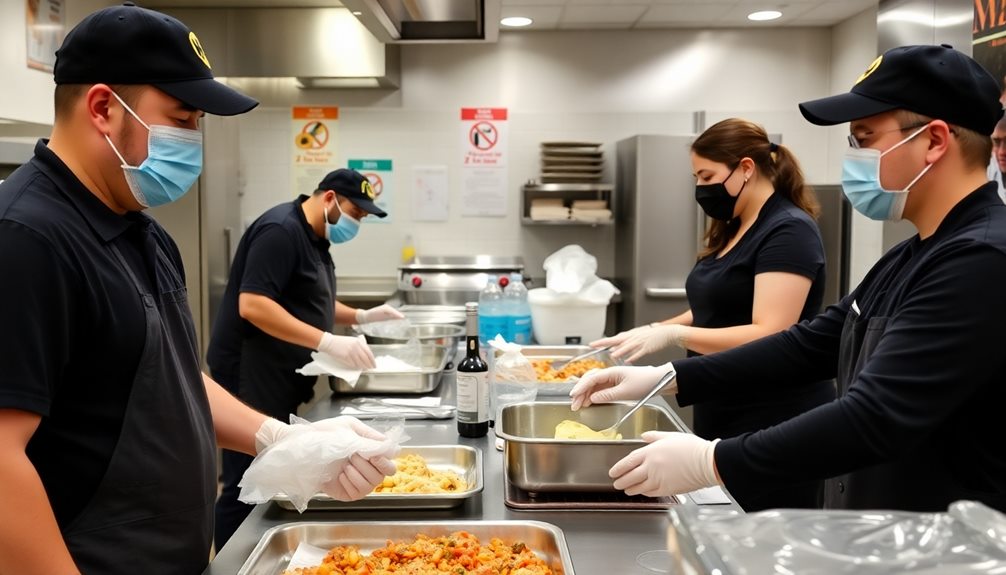
How can restaurants guarantee the health and safety of their employees during the ongoing pandemic? To start, implementing health screening protocols based on CDC guidelines is vital.
Encourage your staff to stay home if they show symptoms or have been exposed to COVID-19. This practice not only protects employee health but also the health of your patrons.
Under the Families First Coronavirus Response Act (FFCRA), you can provide paid sick leave for employees taking time off to receive vaccinations. This support reinforces safety standards within your restaurant.
Maintaining personal hygiene is essential. Require regular handwashing for all staff at key moments—upon arrival, after meals, and after using the restroom.
Additionally, provide personal protective equipment (PPE), like masks and gloves, to food handlers. Confirm employees wear these consistently to minimize virus transmission risk.
Enhanced Cleaning Practices
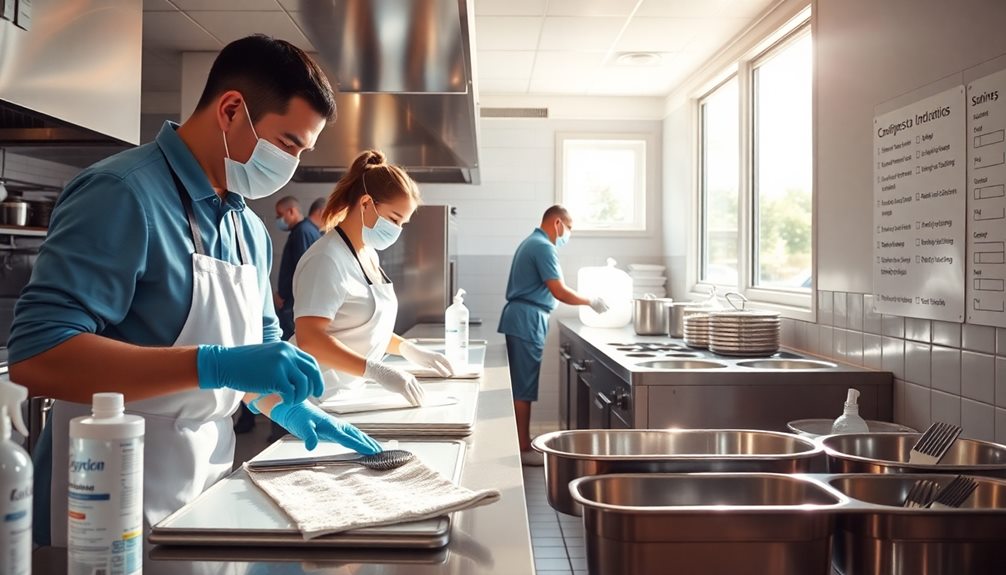
To guarantee a safe dining experience, restaurants must adopt enhanced cleaning practices that prioritize the sanitization of high-contact surfaces. This includes frequent sanitization of door handles, menus, and utensils to mitigate the risk of COVID-19 transmission.
By implementing a cleaning checklist for your staff, you assure consistent adherence to these enhanced cleaning protocols throughout operational hours.
Utilizing EPA-approved cleaning products is essential; these products are specifically effective against SARS-CoV-2, helping to maintain a safe dining environment.
Increasing the cleaning frequency—especially before, during, and after shifts—reinforces hygiene standards and boosts customer confidence in your establishment.
It's also important to regularly review and update your cleaning protocols based on evolving health guidelines.
Staying compliant not only protects public health but also reflects your commitment to safety.
Customer Communication Strategies
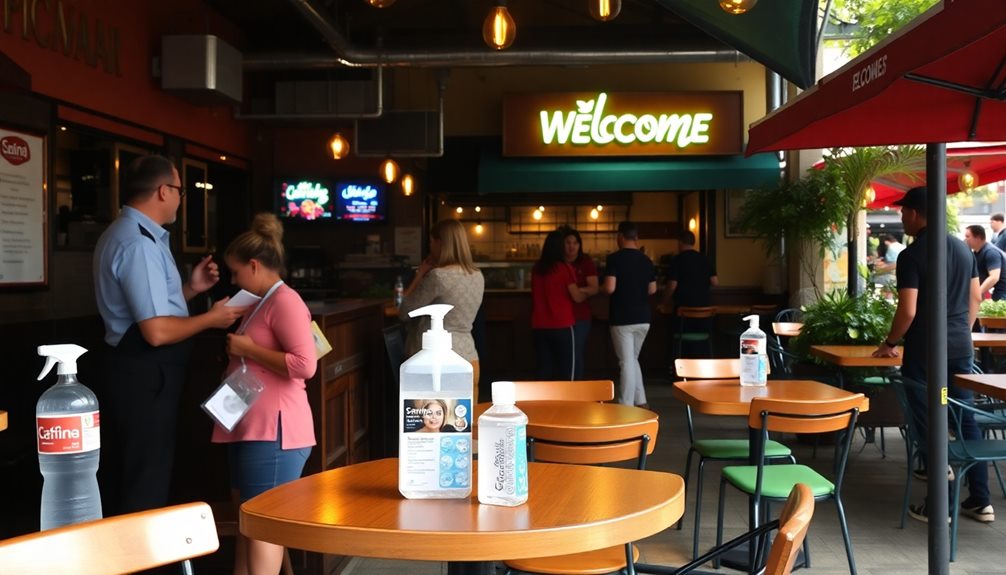
Effective customer communication strategies are essential for restaurants maneuvering through the ongoing challenges posed by COVID-19. Clear signage is fundamental; it informs customers about operational changes and safety measures, reassuring them of their safety during their dining experience.
Utilize delivery platforms and social media to provide regular updates on your safety practices. This transparency builds trust and keeps patrons informed about any changes in service. Additionally, consider implementing preventive measures, such as cross-contact prevention, to further enhance customer confidence in food safety.
Communicating the status of your dining room operations is significant. It helps manage customer expectations and reduces any anxiety related to in-person dining. Address customer inquiries promptly and transparently; this fosters trust and makes patrons feel comfortable with your safety measures.
Don't forget to keep both your staff and customers updated on evolving guidelines and protocols. Consistent communication reinforces your commitment to safety and shows your adaptability in operations.
Innovations in Dining Experience
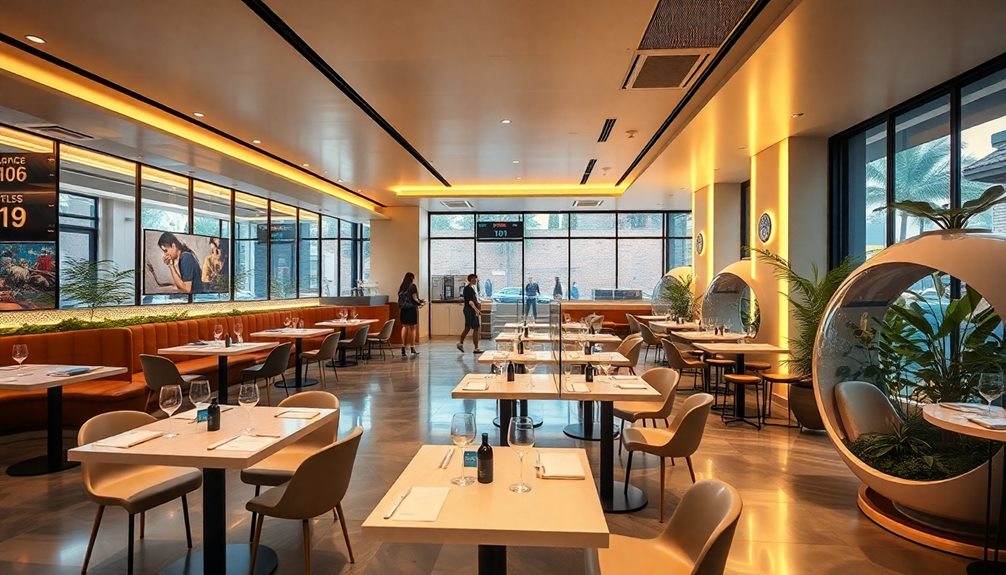
Innovations in the dining experience have transformed how restaurants operate amidst the ongoing pandemic. One significant change is the widespread use of digital QR code menus. This eco-friendly, paperless option minimizes contact with shared objects, making it a safer choice for you and other diners.
Many establishments have also embraced online ordering and contactless payment methods, contributing to a notable 17% increase in restaurant sales in 2023. In addition, restaurants are optimizing their heating and cooling systems to guarantee a comfortable environment for diners, leveraging energy-efficient models that enhance overall guest experience.
Takeout and delivery options have surged in demand, allowing you to enjoy your favorite food from the comfort of home or pick it up curbside. Restaurants have adapted their layouts to include outdoor dining areas, effectively reducing the risk of airborne transmission and enhancing your safety while dining out.
To additionally build your confidence, enhanced cleaning protocols are now standard. Tables and shared objects are sanitized after every use, guaranteeing that hygiene practices are taken seriously.
With these innovations, you can enjoy a dining experience that prioritizes your safety and comfort while still indulging in delicious meals. Restaurants are evolving to meet your needs, combining technology and safety measures to create a new way of enjoying food.
Frequently Asked Questions
What Are Some of the OSHA Safety Regulations That Are Specific to Restaurants?
You need to focus on OSHA regulations requiring a hazard-free workplace. This includes providing PPE, conducting health screenings, implementing a COVID-19 prevention plan, training employees on hygiene, and ensuring proper ventilation in your restaurant.
What Are the CDC Guidelines for Food Service During Covid 19?
Think of a shield protecting a castle. The CDC's guidelines are your shield—ensure employees don't work if sick, clean surfaces, maintain distance, wear masks, and embrace outdoor dining to keep everyone safe and healthy.
What Are the Safety Procedures for Covid 19?
To guarantee safety during COVID-19, you should follow health screenings, maintain social distancing, wear face coverings, frequently disinfect surfaces, and consider outdoor spaces for better ventilation. These steps help reduce transmission risks effectively.
What Precautions Should Be Taken in Covid 19 Workplace?
In a COVID-19 workplace, you should conduct health screenings, enforce mask-wearing, maintain social distancing, enhance cleaning protocols, and promote contactless interactions. These precautions help guarantee a safer environment for everyone involved.
Conclusion
As restaurants adapt to the ongoing challenges of COVID-19, your safety remains their top priority. Did you know that 70% of diners are more likely to visit a restaurant that clearly communicates its safety measures? By staying informed about vaccine access, enhanced cleaning practices, and innovative dining experiences, you can enjoy your meals out with peace of mind. So, next time you dine, remember that these measures are designed to keep you safe while you savor your favorite dishes!
